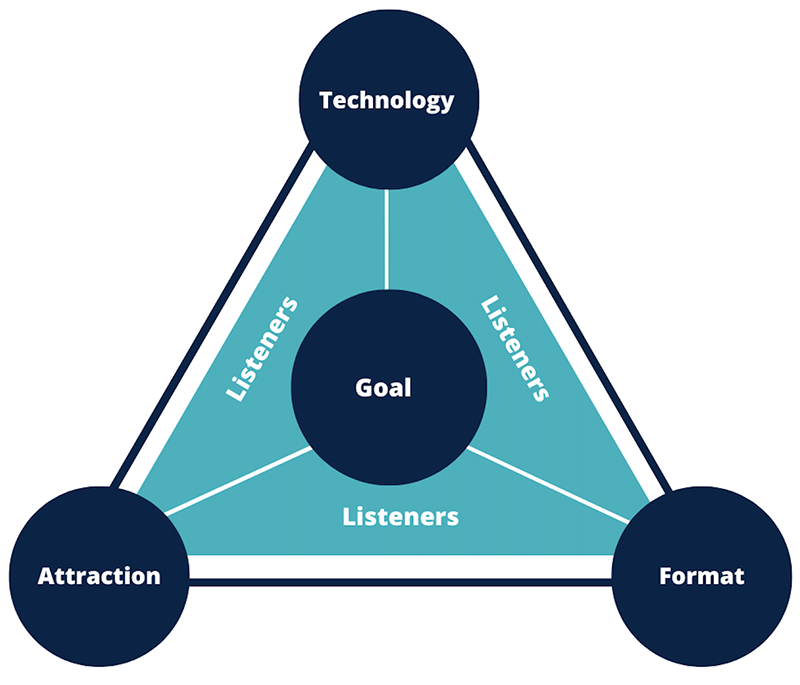In this piece
Focus on your listeners: how to build a content model for successful podcasting

Podcasting has grown rapidly since its inception in 2004: listeners can now choose from 4.4 million different shows. This content strategy model hopes to help podcasters stand out in a crowd. REUTERS/Carlo Allegri
Since the advent of podcasting in 2004, the industry has grown exponentially. Consider these three metrics:
- The number of listeners in the U.S. increased by almost 40% between 2010 and 2020, according to The Infinite Dial reports.
- The number of podcasts on Spotify doubled between 2020 and 2021 to 4.4 million shows.
- The value in terms of revenue recorded by IAB increased by 192% from $479.1 million in 2018 to $1.4 billion in 2021. By 2024 that figure is projected to reach over $4 billion.
As the amount of… well, everything increases in the podcast industry, the quality of the content you produce will play a central role in determining whether you succeed in standing out in a crowded market place.
But what determines content quality in 2022? This paper will define the core elements of podcast content by introducing the Glaft Model, and then help you define – through a series of questions – your own strategy concerning each element.
My goal in this project was to create a simple graphic model for podcast producers to consult. I wanted a working tool that would help creators consider the most crucial determinants of future success: Goal, Attraction, Format, Technology and Listeners, and all the ways they are interwoven.
It’s all so very simple and obvious that you may look at each section and say to yourself, ‘Yes, I already knew that’. And yet, based on my experience with producers, these incredibly straightforward components are the ones most frequently overlooked, and most frequently the cause of show failure.
The 'Glaft Model'

The most common mistake I hear in demos is that the listener – and their listening experience – is not taken into account in tandem with the producer's own interests. The podcaster's goal – or the producer’s – is often clear; the listener’s reason for listening is not. And yet the common ingredient of all successful podcasts is that the listener gets something from listening: they profit from the investment of their time.
The other components that contribute to podcasting excellence:
- Goal
- Attraction
- Format, and
- Technology
These four elements interwoven with the fifth component, Listeners, make up the Glaft Model. It will have you ask "why" and "who" (Goal and Listener value), "what" (Attraction), and "how" (Format and Technology).
All of the components of the Glaft Model are important, interconnected, and impact each other. If one component fails, the model (and your content) will fail.
For a full explanation of each component, including examples, download the PDF below. Alternatively, answer the following questions about your podcast series (or episode).
Goal
- Why is this podcast being produced?
- Who is going to listen to this podcast?
- Why should the listeners engage with this podcast?
- What are the listeners missing if they do not listen to this podcast?
- When should it end?
Attraction
- What is the subject of your show?
- How many episodes can that subject sustain with passion?
- What core emotion(s) does this subject elicit in Listeners?
- Who is the best person to present this subject to your Listeners, and why will Listeners keep coming back for them?
- Is this Attraction in alignment with your Goal?
Format
- What Format will best showcase the Attraction of your show?
- What Format will most appeal to your intended Listeners?
- What tone will meet your Listener’s needs, and is that tone in alignment with your show Goal?
- What does the beginning of your show promise?
- What does the middle of your show deliver?
- Does the end of your show make Listeners want to come back?
- Is there a way to include your Listeners in the format of your show?
- In what way does your Format stand out from other shows?
Technology
- Where are you recording the episodes?
- What will you edit out of (and into) the show?
- How will recording and editing highlight the Attraction?
- Does your chosen Format affect your Technology needs?
- Does the Technology meet your Listener needs and show Goal?
By answering all of the questions, you should find you have the keys to a cohesive content strategy for your show. You can use the answers from each section to complete a mission statement for your project:
In order to [insert producer’s Goal], we are creating a show for [describe your Listeners] about [state your Attraction, whether subject and/or host] to [describe Listener’s reason for returning, which may be informed by emotional need]. The show is unique because it [describe what is unique about your format] and it is delivered with [describe your Technology-related recording and editing standards].
The Glaft Model can be applied to a whole series or just one episode of a podcast. But it won’t tell you how to market your podcast, and it won’t tell you how to distribute it. Others have already done this work elsewhere. Besides: expensive marketing and distribution strategies may give you a short-term bump in reach, but neither will help you retain an audience if your content strategy is weak.
I hope that this model will be used to plot out content strategies and craft mission statements for many exciting new shows. A final word of caution: this model will hold in 2022 but – as the podcast industry continues to evolve rapidly – it will need to continue to evolve to keep pace with changes. If you are consulting this paper at any point beyond 2023, use it to check your basics but consider how the industry has changed, and adapt your answers accordingly.




